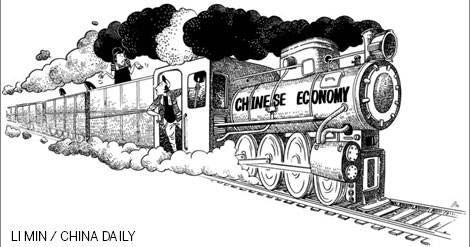Op-Ed Contributors
Choices the economy has to make
By Mark Williams (China Daily)
Updated: 2010-08-24 09:53
 |
Large Medium Small |
You don't have to spend long listening to Chinese officials talk about economic policy before certain themes start cropping up. The government wants to sustain rapid growth this year and next, we are told. It is trying to rein in policy-directed lending and the associated risks to banks. And it is determined to engineer a more sustainable form of growth that delivers greater benefits to workers.
Each is a worthy objective. Of course, achieving them will be easier said than done. But the issue is not that realizing any one of these goals is beyond the government's ability. The problem is that China simply cannot achieve all three at the same time. There is a fundamental inconsistency between them. At some point, perhaps as soon as in the next few weeks, choices must be made that will help determine the path that China's economy follows in the years ahead.
The starting point is that economic growth is now slowing. This was always going to happen as the surge in spending from the stimulus programme began to ebb away. The stimulus was a great success in bridging the gap in demand that opened up as global purchases of Chinese exports collapsed.
But now that the immediate crisis has passed and the developed economies are growing again, albeit fitfully, the extent of China's structural reliance on overseas demand is set to be exposed. Not only is export demand unlikely to keep growing at anything near the pre-crisis rates, but also investment spending will be subdued as firms realize they cannot rely on finding a market overseas for whatever they fail to sell at home.
The first challenge, then, is maintaining rapid growth in such an environment. The government is normally thought to target GDP growth of at least 8 percent year-on-year. On current trends, and without further stimulus, that pace will be undershot by the end of the year.
There has been a lot of talk in policy circles recently that what matters is not so much the pace of growth, but its quality (usually meaning how effective it is at boosting jobs and wages and how much it damages the environment). A GDP growth of 7 percent or so would be no disaster if it was accompanied by rapid increases in household incomes and put less stress on the environment.
But that is not what China faces now. The economic slowdown is not the result of a healthy structural shift in the economy. Instead, it is simply the reflection of the fact that the old, "low quality" sources of demand are weaker than before.
So what might the government do? A return to stimulus is the obvious answer. But what form will this take? Over the past two years, stimulus has been predominantly channelled through loan-fuelled investment. Officials, however, have spent the last few months trying to slow the flow of funds to the local government investment vehicles that implemented much of the earlier stimulus for fear that they will be unable to service debts.
Might there be room to boost household spending instead? Certainly, the government continues to talk about the importance of consumption in supporting strong and sustainable growth and this will be an essential part of any shift to a more sustainable economic path. But the impact of policies adopted in 2009 to boost consumption is already fading, although those policies - including tax breaks on cars and subsidies for household appliance purchases - are still in place. For example, vehicle sales soared in 2009 but have been in decline since the start of the year.
These stimulus policies could be expanded, or supplemented with larger transfers to low income households (which tend to spend more of their income). But the lesson of the last 18 months is that such schemes have, at best, a temporary impact.
Admittedly, some of the investment boost of the past two years will help support consumption over the long run, for example, by knitting markets closer together and reducing logistics costs. The ongoing structural shift in the workforce should also gradually boost households' share of national income. But these changes will play out over many years and will not bridge the gap in growth that is opening up today.
Could fiscal policy be part of the answer? It would make sense to run a larger budget deficit, which in 2009 was just 2 percent of GDP. But this extreme conservatism in the face of the biggest shock to growth in a decade only underlines how reluctant the government is to use its fiscal tools.
In the end something will have to give in. Recent experience suggests that it will be the government's vigilance over banking sector risks and its attempts to put a cap on lending. Rapid economic growth will be achieved, but by allowing banking sector risks to increase. What's more, if maintaining rapid growth is the first priority, then serious attempts to lower the environmental impact of that growth are likely to fall by the wayside.
The author is a senior China economist at Capital Economics, a London-based independent macroeconomic research consultancy.
|
 |